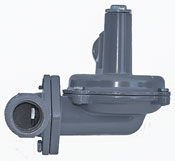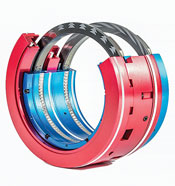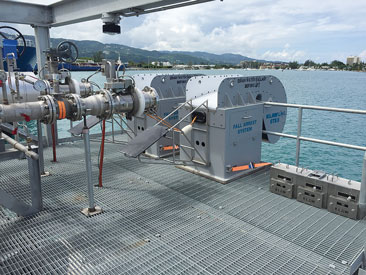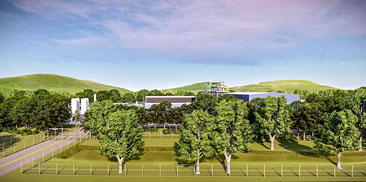New in Gas Processing Technology
A. Blume, Editor
Natural gas and innovation drive GHG reductions
The American Petroleum Institute (API) issued a statement regarding the US Environmental Protection Agency’s release of data from its Greenhouse Gases (GHG) Reporting Program report. The report continues to show a downward trend in GHG emissions, even as US oil and natural gas production grows dramatically.
API Senior Director of Regulatory and Scientific Affairs Howard Feldman said, “The US leads the world both in natural gas and oil production and in cutting GHG emissions. Clean natural gas produced through advanced technologies like hydraulic fracturing is playing a significant role in driving carbon dioxide emissions to 25-yr lows.”
Feldman also noted, “The natural gas and oil industry has invested more than double the next-highest industry sector in zero- and low-emissions technologies—since 2000—to deliver the affordable and reliable energy we need while protecting human health. The environment and industry’s initiatives, highlighted by programs such as The Environmental Partnership, will further environmental progress.”
Orbital, Mitsubishi agree to enhance product lines
 |
Orbital Gas Systems, a wholly-owned Energy subsidiary of CUI Global Inc., has entered into a technical collaboration with Mitsubishi Electric Europe BV to further enhance Orbital’s remote telemetry unit (RTU) and BioMethane product lines with Mitsubishi’s automation control platforms.
The partnership will ensure that Orbital continues to utilize optimum-industry-standard equipment for its product lines. Mitsubishi Electric will provide the hardware product platform and technical support, with Orbital contributing system design and implementation expertise.
Customers will benefit from the continuity of Mitsubishi Electric product support, diversity of implementation knowledge and fast turnaround of hardware supply. Both companies will partner in the marketing and sales of the product lines. The services will initially benefit UK gas transmission and gas distribution networks, with further collaboration expected throughout Europe and North America.
BelGAS introduces Type P140 pressure regulators
 |
BelGAS has introduced its Type P140 pressure regulators for a wide range of gaseous fluids, including air, natural gas, propane and general-purpose pressure regulation. The P140 offers accuracy and a compact design, and is available with or without internal relief.
The P140 is designed to be reliable and economical—a balance that is key for the many markets the device serves. It has an iron body, aluminum bonnet and other components made of stainless and zinc-plated steel and nitrile.
Pressure delivery of 5 in. wc to 5 psi is available. Body sizes include 0.75 in., 1 in. and 1.25 in., with straight or angled body configuration and a variety of standard and custom-sized orifices.
John Crane launches seal technology to reduce emissions
 |
John Crane has launched gas seal technology designed to be retrofitted into centrifugal compressors with oil seals to significantly lower operating costs, improve reliability and reduce methane emissions by up to 95%.
The Aura 120 Narrow Section gas seal enables the latest John Crane gas seal technology to be fitted into a larger percentage of older equipment, bringing with it the benefits of non-contacting design. Gas seal technology eliminates the need for oil lubrication associated with contacting seals and the resulting need to address harmful emissions entrapped in the oil. In the natural gas sector, centrifugal compressors equipped with oil seal technology are generally acknowledged as the leading source of methane emissions offshore and the fourth most significant source onshore.
John Crane’s LCC takes operational data from rotating equipment and compares the total lifecycle costs of the oil seal operation—including emissions—with the option of capturing the methane and routing to a flare device, capturing the methane and routing for another purpose, and retrofitting to gas seal technology.
John Crane identified four typical scenarios where oil seals are still in use and examined the economic benefits. In all scenarios, converting to gas seal technology provides economic payback, particularly when there is no spare compression and the operator owns the natural gas flowing through the compressor.
Earlier this year, John Crane was invited by a United Nations (UN) panel to showcase how the firm’s technology is reducing methane emissions in sectors of the natural gas industry. The panel is examining the critical role gas will play in achieving the international organization’s Sustainable Development Goals.
The UN group provides a forum for multi-stakeholder dialogue on sustainable and clean production, distribution and consumption of natural gas in the United Nations Economic Commission for Europe (UNECE) region. It established a taskforce to develop best practice guidance on reducing methane emissions along the gas value chain.
Pioneered by John Crane, gas seal technology became widely available in the 1980s and is now recognized as the current industry standard for all new equipment, providing a cost-effective, reliable, low-emissions shaft seal solution for centrifugal compressors and other rotating equipment.
KLAW offers SIL2-compliant LNG hose transfer
 |
KLAW LNG offers a Safety Integrated Level Safety Instrumented System (SILSIS) LNG hose transfer system, the world’s first SIL2-compliant automated system for managing LNG transfers and emergency situations in flexible hose operations.
SILSIS is a fully automated programmable logic controlled (PLC) system. Not only does SILSIS offer minimal operational disruption by offering the ability to proof test and diagnose issues without the need for invasive inspection, but its real-time interface also ensures that operators can follow procedures without distraction.
Air Products expands Manatee LNG manufacturing
 |
Air Products recently launched a new LNG equipment test facility and a manufacturing expansion project at its Port Manatee, Florida site. The location of the equipment test facility at the Port Manatee manufacturing facility consolidates Air Products’ LNG investments at the Florida location.
The equipment test facility will allow for the collection of data to develop designs for the next generation of Air Products coil wound heat exchangers. To date, 116 large coil wound heat exchangers have been deployed by Air Products at LNG facilities throughout the world.
The company is also increasing the manufacturing capacity of the facility at Port Manatee by more than 50%. Air Products dedicated its Port Manatee facility in January 2014 and rolled out its first LNG heat exchanger from the facility in September 2016. In addition to LNG heat exchangers, the Port Manatee facility also builds specialty cryogenic and gas processing equipment for a wide range of other industrial markets.
Typically, an LNG heat exchanger can be more than 15 ft in diameter and 180 ft long, or about two-thirds of the size of a football field. A finished unit can weigh as much as 500 tons.
A majority of total worldwide LNG is produced with Air Products’ technology. In support of the LNG industry, Air Products provides process technology and key equipment for the natural gas liquefaction process for large export plants, small and mid-sized LNG plants, floating LNG plants and LNG peakshaving plants.
Upstream, Air Products provides both nitrogen and natural gas dehydration membrane systems for offshore platforms. Downstream, Air Products provides membrane nitrogen generators for LNG carriers, and land-based membrane and cryogenic nitrogen systems for LNG import terminals and baseload LNG plants.
Siemens receives order for 100th reciprocating compressor
 |
Siemens’ Dresser-Rand business marked a milestone when a large-cap midstream operator recently purchased its 100th heavy oilfield separable (HOS) compressor from the company. With this latest order for 11 HOS compressors, the Permian Basin customer has ordered a total of 106 high-speed reciprocating compressors from the Dresser-Rand business since 2012.
The new units will be used for gas gathering in the West Texas Permian Basin. The gathering system where the compressors will be installed has approximately 4,500 miles (7,242 km) of natural gas gathering pipelines located across nine counties within the Permian Basin in West Texas, and has an aggregate processing nameplate capacity of 875 MMft3d.
Two new, 250-MMft3d plants, for which the HOS compressors will be used, are expected to begin operations in 2019. Building upon Dresser-Rand’s process compressor design, whereby 24,000-hp compressors are designed to operate without interruption for 3-yr to 5-yr intervals, the HOS compressors are lower cost and the packages can be delivered quickly.
Additionally, the HOS compressor can be applied to hydrogen, nitrogen and other process requirements. The HOS compressor is engineered for higher-hp applications, including gas lift, gas gathering, pipeline boosting, gas transmission, underground gas storage (injection and withdrawal), fuel gas boosting, landfill gas recovery and many others.
The compressors are suited not only for sweet natural gas services, but they can also handle sour natural gas, propane, carbon dioxide, air, nitrogen and most other gases. Rated to 7,200 hp (5,370 kW) and 1,500 rpm, with design pressures up to and exceeding 6,600 lbf/in.2 gauge (455.05 bar), HOS compressors provide long life due to their heavy-duty construction.
They are available in two-throw, four-throw or six-throw configurations and in cylinder sizes ranging from 3.75 in. (95.3 mm)–26.5 in. (673.1 mm).
Abriox introduces wireless pressure monitoring system
 |
The US Energy Information Administration (EIA) reported that natural gas production will rise more than expected—by nearly 1 Bft3d—in 2018, due to an uptick in exports and gas-fired electricity generation.
To help distribution companies improve network efficiency, Abriox has introduced Osprey, a remote gas pressure monitoring system designed to save time and money while improving the quality and reliability of data collection.
Osprey claims to deliver higher accuracy than loggers, meters and chart recorders. The system provides continuous monitoring without the need for onsite personnel or maintenance, giving users a rapid return on investment. The wireless, portable device is quick to install and generates instant alerts to indicate abnormal pressure levels in distribution networks.
Certified to Class 1, Division 1, Osprey is available in single-channel and multi-channel models, offers flexible pressure ranges and has a sensor accuracy of ±0.15% FS. A key feature of Osprey is its built-in GPS module. In addition to displaying its geographical location, the data collected from satellites allows Osprey to establish the exact time and date of every pressure measurement it records. Other devices on the market are subject to electronic drift, making their data less accurate and requiring companies to manually realign measurements.
For example, Osprey can be deployed in a poor pressure situation and it will immediately start generating accurate readings to a cell phone using text messaging. According to Osprey, this is the equivalent of sending an engineer to the site and repeatedly asking for pressure data—but without the costs.
In cases of fluctuating pressure, poor pipe design, freezing temperatures or water ingress, the system is equipped with incident evaluation mode (IEM) for fast deployment of investigative or remedial work. Osprey can run in IEM mode permanently at sites that require constant updates for the cost of just two sets of commercially available batteries per year. The batteries can be installed by the user without the need to return the unit to Abriox.
Osprey has a long operating life, is compact and requires minimal maintenance. Its superior accuracy and configurable data collection options make compliance with regulatory requirements transparent. Osprey has a small carbon footprint, and its autonomy promotes safer working conditions for personnel. The monitor, with its large data capacity and reliable remote communication, gives companies dedicated monitoring that can link to their business planning model. Abriox's PressureTrac software package is designed to interface with a user's modeling or asset management software and can automate the process.
Elliott to relocate cryo pumps operations
 |
Elliott Group plans to relocate manufacturing and testing of its cryogenic pumps and expanders to Jeannette, Pennsylvania. The pumps and expanders, which are used in gas liquefaction applications, are a new addition to Elliott’s product lines following the acquisition in October 2017 of Ebara International Corp.’s Cryodynamics Division.
The cryogenic pumps and expanders will be manufactured at Elliott’s global headquarters. The ability to test these products prior to shipping is a key element of the manufacturing proces. A new, separate test facility is being developed for this purpose.
Port Arthur LNG, Sabine Pilots run docking simulations
 |
In Southeast Texas, it is the duty of the Sabine Pilots to maintain the safety and environmental integrity of the Sabine-Neches Waterway. The Sabine Pilots have served the shipping industry, the public ports of Port Arthur, Beaumont and Orange counties, and the private oil terminals and industrial complexes in the area since 1881.
Sabine Pilots captains joined the Port Arthur LNG Marine Operations team to run more than a dozen simulations in support of the liquefaction project. The goal of these simulations was to re-test and affirm project design elements, including the turning basin and berthing area required for a Q-max-sized LNG carrier to safely dock at the proposed Port Arthur LNG terminal under a number of different environmental conditions, such as wind and current.
The LNG carrier bridge simulations were hosted by the US Maritime Resource Center (USMRC) located in Middletown, Rhode Island. The USMRC staff used proposed Port Arthur LNG blueprints to build an exact terminal replica for use in several different, real-time scenarios for the pilots to navigate.
The feedback from the simulations included discussions on items ranging from the design of the tugboats and placement of the tug dock, to the number of wind monitors needed and where they should be located, to validating the basin and berth design.
From a marine operations perspective, plans for construction of the Port Arthur liquefaction facility will include two jetties, a turning circle, loading arms, mooring equipment and other associated apparatus that will deliver LNG from the vessel to and from the terminal. The Q-max vessel, which is a little larger than an aircraft carrier, has a capacity of up to 266,500 m3.
GTT receives order to design LNG carrier tanks
GTT has received an order notification from Samsung Heavy Industries (SHI) for the tanks design of an LNG carrier on behalf of Japanese shipowner Nippon Yusen Kaisha (NYK).
GTT's Mark III Flex membrane containment system has been selected to equip the LNG carrier, offering a capacity of 174,000 m3. The vessel's delivery is scheduled for Q1 2021.




Comments